This article was medically reviewed by Victor Catania, MD. Dr. Catania is a board certified Family Medicine Physician in Pennsylvania. He received his MD from the Medical University of the Americas in 2012 and completed his residency in Family Medicine at the Robert Packer Hospital. He is a member of the American Board of Family Medicine.
There are 9 references cited in this article, which can be found at the bottom of the page.
wikiHow marks an article as reader-approved once it receives enough positive feedback. This article received 14 testimonials and 100% of readers who voted found it helpful, earning it our reader-approved status.
This article has been viewed 518,508 times.
If you are suffering from sinus pressure or congestion, massaging your sinuses may help to alleviate some of your irritation. Massaging the sinuses and the tissues surrounding the sinuses can help relieve the pressure and drain mucus-filled sinuses. There are different kinds of massages you can try, including a basic, full-face massage as well as massages designed for specific parts of your face. Keep in mind that you can mix any of these techniques and massage just one or all your sinuses.
Steps
Performing a Basic Sinus Massage
-
1Rub your hands and fingers together to warm your fingers. Warm hands and fingers are more comforting for the sinuses than cold hands and fingers. Cold hands and fingers can cause muscle tension.
- One option is to place a small amount of oil on your palm (about a quarter-sized amount). The oil helps to lessen the friction caused by your hands rubbing against your face. The scent of the oil may also help to promote relaxation. Good oils to use for a sinus massage include almond oil, baby oil, or castor oil. Just make sure to not get any of it in your eyes while you massage close to those areas.
-
2Locate the indentation of the eye sockets. The indentation of the eye sockets are located on either side of where the bridge of the nose meets the ridge of the eyebrows. When pressure is applied to this area, it can help to relieve colds, sinus congestion, frontal sinus headaches and tired eyes.
- Use your thumbs. The thumbs are recommended because they tend to be stronger than other fingers. For other people, using the index finger may be more comfortable. Do whatever feels the most soothing and comfortable for you.
Advertisement -
3Apply finger pressure directly on the indentation of the eye sockets. Do this for one minute The amount of pressure you apply should be somewhere between pleasant and firm.
- Then, press your fingers into the area and move them in a circular motion for two minutes.
- Keep your eyes closed as you massage this area.
-
4Apply pressure to your cheeks. Move your thumbs, or alternatively, your index and middle fingers so that they are placed on either side of your cheek, just outside each nostril. When pressure is applied to this area, it can help to relieve nasal congestion and sinus pain.
- Apply firm and constant pressure on your cheeks for about a minute.
- Then, move your fingers in a circular motion for two minutes.
-
5Stop the massage if you feel any pain. If there is a buildup of pressure in your sinuses, this basic massage may feel a little intense, and this is normal. However, if you feel any deep pain, you should stop and try an alternative remedy or consult your doctor.
Targeting Specific Sinuses
-
1Massage your frontal sinuses. Your frontal sinuses are located in the region of your forehead. Rub lotion or massage oil onto your warmed hands in order to help smooth your fingers along your face without friction. Place both of your index fingers in between your eyebrows in the center of your forehead. Using a circular motion; run your fingers from in between your eyebrows out towards your temples.
- Repeat this movement 10 times using constant and firm pressure.
- Make sure your hands are warm before beginning this massage. Rub your hands together to create a bit of friction and heat.
-
2Try massaging your ethmoid/sphenoid sinuses. These are your nasal sinuses. Pour a small amount of massage oil or lotion onto your hands and rub them together to warm them up. Use your index fingers to stroke along the side of the bridge of your nose in a downward motion; this will help promote drainage. When you work your way up towards the top of your nose (the bridge), make small circles with your index fingers next to the corners of your eyes.
- However, do not touch your eyes or get oil into your eyes. The oil won't harm your eyes but you may experience stinging.
- Repeat this movement 10 times, all the while applying constant and firm pressure.
-
3Learn how to massage your maxillary sinuses. Again, apply lotion or massage oil to your hands and rub them together to warm them up. Using your index fingers, apply downward pressure on each cheek near the outside corners of your nostrils. Using small circular movements, work your fingers along your cheekbones towards your ear.
- Repeat this movement 10 times. Again, you should use a firm pressure here to maximize relief.
-
4Relieve sinuses using the nose rub technique. The technique is recommended for individuals with sinus problems, a stuffy nose, and nasal congestion. Rub oil in your hands. Use the palm of your hand to rub the tip of your nose in a circular motion, repeating this movement 15 to 20 times.
- Change directions and rub your nose the other way in a circular movement 15 to 20 times. For example, if you rubbed your nose clockwise for the first 15 movements, rub your nose in counterclockwise circles for the next 15 movements.
-
5Attempt to drain your sinuses through massage. Pour a small amount of lotion into your hands and rub them together. Using moderate pressure, use your thumbs to massage from the middle of the forehead towards your ears. Repeat this movement two or three times.
- Place your thumbs on the middle of your nose and begin massaging out towards your ears. Repeat this movement two or three times.
- Place your thumbs under your jaw and run your thumbs down along the sides of your neck to your collarbones.
Combining Massage and Steam Treatments
-
1Do a steam before or after a sinus massage. By combining the steam method described below along with the massage techniques already described, you can significantly increase sinus drainage. While increasing sinus drainage is not very pleasant, draining the excess mucus can relieve the pressure in your sinuses quickly and effectively.
- Steaming is an old method of relieving sinus pressure without chemicals or drugs. The steam helps open up the nasal passages and thin out the sometimes thick mucus, thereby enabling it to drain out of the sinuses.
-
2Fill a one-quart pot with water. Boil the water on the stove for a minute or two or until it is steaming vigorously. Then remove the pot from the heat and place on a heat-resistant mat on a table.[1]
- You want the steam to enter into your nasal passages and your throat but not at the cost of potentially burning yourself.
- In addition, keep any children away from the pot while it is boiling and while it is steaming. Try to do a steaming treatment when there aren't any children around.
- This method is for adults only — do not try it on children.
-
3Drape a large, clean cotton towel over your head. Then, place your head over the steaming pot. Close your eyes and keep your face at least 12 inches away from the water so that you don't burn yourself.[2]
-
4Breathe in through your nose and out through your mouth. Do this for five counts. Then reduce the inhales and exhales to two counts. Do this 10 minutes or for as long as the water is still steaming. Try to blow your nose while you're doing the treatment and then afterwards.[3]
-
5Steam up to every two hours. You can use this technique frequently, up to every two hours. You can do give yourself a steam every two hours or as often as you like by placing your face over the steam coming from a hot tea or bowl of soup when you're at work or out and about.[4]
-
6Add herbs to your steaming treatment. You can also add herbs and essential oils (one drop per quart of water ) to your steaming water. Some people think oils and herbs can relieve symptoms, but these claims are not backed by scientific evidence.
- Spearmint or peppermint, thyme, sage, lavender, and black lavender oil are all great options to start with.[5] [6] [7]
- If you have been diagnosed with a fungal sinus infection, add a drop of black walnut essential oil, tea tree oil, oregano or sage oil to your steaming water. These are thought to have antifungal and antiseptic properties.[8] [9] [10]
- Test your sensitivity to the herb you want to use before doing a full steam treatment. Try each herb oil for about a minute and then take your face away from the steam for 10 minutes and assess how you feel. If you do have any adverse reactions (such as sneezing or a skin reaction like a rash), reheat the water and do the full treatment.
- If you don't have the essential oils, substitute a 1/2 teaspoon of dried herb per quart of water. For dried herbs, boil for another minute after adding, turn off the heat and move the pot to a safe area in your home and begin steaming.
-
7Take hot showers. Taking a long, hot shower can have a similar effect to the steam treatment above. The hot water from the shower creates warm, moist air that helps to clear out blocked nasal passages and relieve sinus pressure. Try blowing your nose naturally. The heat and steam will help moisten and liquify the secretions in the sinuses to better facilitate their evacuation.[11]
- You also achieve a similar beneficial effect by placing a warm compress on your face to help open up your nasal passages and relieve any pressure you might be feeling in your sinuses. Warm a moist washcloth in the microwave for two to three minutes. Always take care not to burn yourself.[12]
Warnings
- Never press against any area in an abrupt, forceful, or aggressive way. You want to use firm, but gentle pressure. "Knead" the skin and muscle like very thin dough.⧼thumbs_response⧽
- If you're experiencing pain or severe congestion that isn't relieved by massage or other simple remedies (aspirin, steaming, drinking lots of water, etc.) after 48 hours, consider scheduling an appointment with your physician.⧼thumbs_response⧽
- Do not massage areas inside or outside which have unhealed burns, cuts, or ulcerations.⧼thumbs_response⧽
References
- ↑ http://www.emedicinehealth.com/sinus_infection/page6_em.htm
- ↑ http://www.emedicinehealth.com/sinus_infection/page6_em.htm
- ↑ http://www.emedicinehealth.com/sinus_infection/page6_em.htm
- ↑ http://www.sudafed.com/know/sinus-pain-headache-pressure
- ↑ Kamatou GP, Vermaak I, Viljoen AM, Lawrence BM., Menthol: a simple monoterpene with remarkable biological properties.Phytochemistry. 2013 Dec;96:15-25.
- ↑ Fournomiti M, Kimbaris A, Mantzourani I, Plessas S, Theodoridou I, Papaemmanouil V, Kapsiotis I, Panopoulou M, Stavropoulou E, Bezirtzoglou EE, Alexopoulos A. Antimicrobial activity of essential oils of cultivated oregano (Origanum vulgare), sage (Salvia officinalis), and thyme (Thymus vulgaris) against clinical isolates of Escherichia coli, Klebsiella oxytoca, and Klebsiella pneumoniae. Microb Ecol Health Dis. 2015 Apr 15;26:23289.
- ↑ Sienkiewicz M, Głowacka A, Kowalczyk E, Wiktorowska-Owczarek A, Jóźwiak-Bębenista M, Łysakowska M.The biological activities of cinnamon, geranium and lavender essential oils. Molecules. 2014 Dec 12;19(12):20929-40.
- ↑ Sienkiewicz, M.,Łysakowska, M., Ciećwierz, J.,Denys, P.,Kowalczyk, E.Antibacterial activity of thyme and lavender essential oils. Med Chem. (UAE); 7(6): 674-689, 2011.
- ↑ Hammer, KA., Carson, CF., Riley, TV. Antifungal activity of the components of Melaleuca alternifolia (tea tree) oil. Antifungal activity of the components of Melaleuca alternifolia (tea tree) oil.
- ↑ Özcan,M., Boyraz,N., Antifungal properties of some herb decoctions. European Food Research and Technology December 2000, Volume 212, Issue 1, pp 86-88.
- ↑ http://www.emedicinehealth.com/sinus_infection/page6_em.htm
- ↑ http://www.webmd.com/allergies/sinus-pain-pressure-11/sinus-congestion
About This Article
To massage your sinuses, start by using your fingertips to apply pressure to the area where the bridge of your nose meets your eyebrows. Move your fingertips in a circular motion as you apply pressure. Then, move your fingers to your cheeks, right on the side of your nostrils. Apply pressure and move your fingers in a circular motion there as well. If you feel any pain, try applying less pressure with your fingertips. To learn how to do more advanced massages, scroll down!

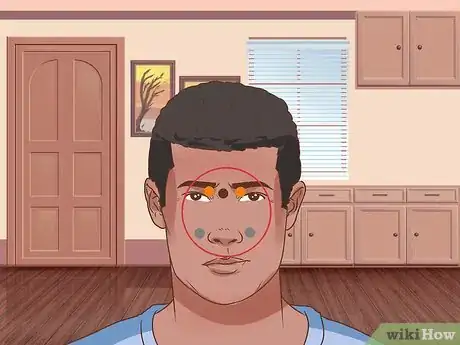
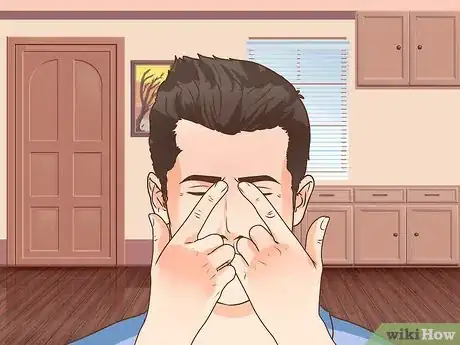
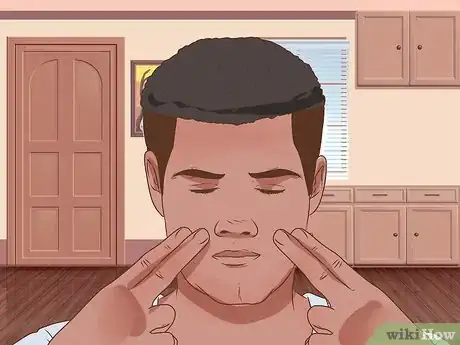
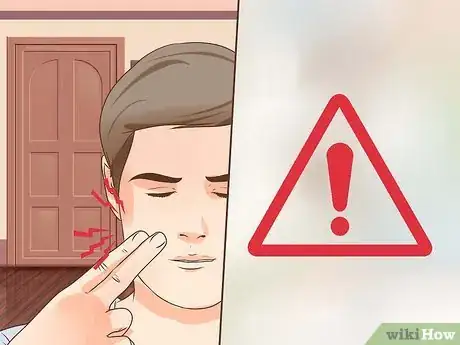
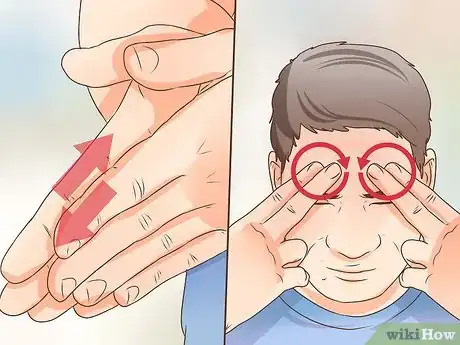
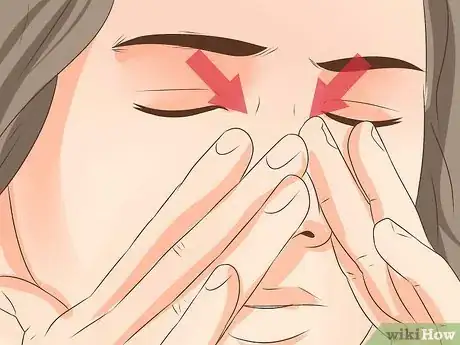
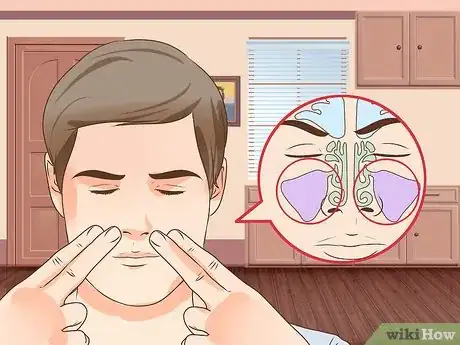
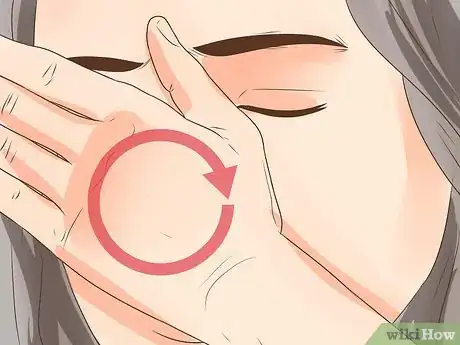
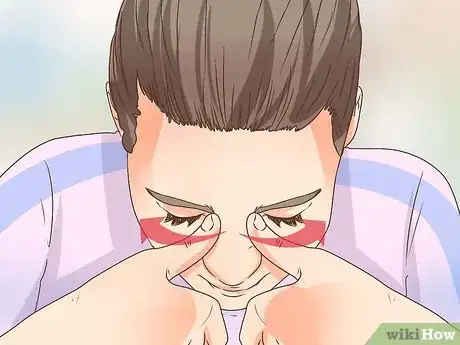
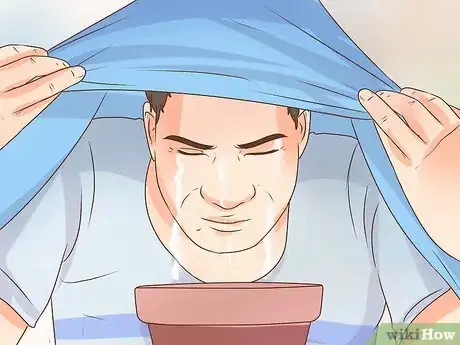
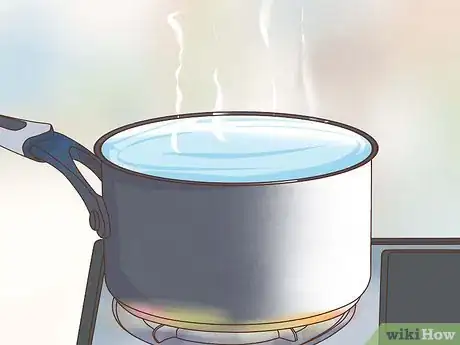
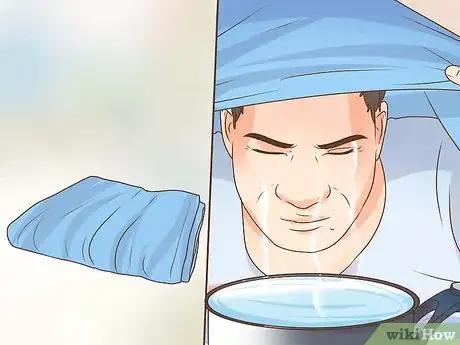
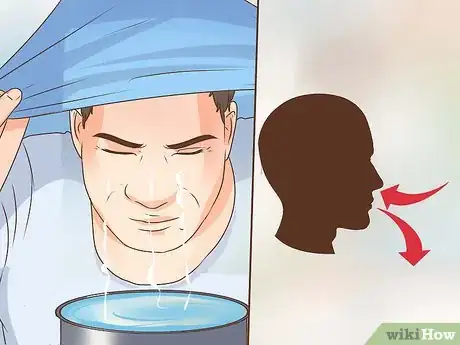
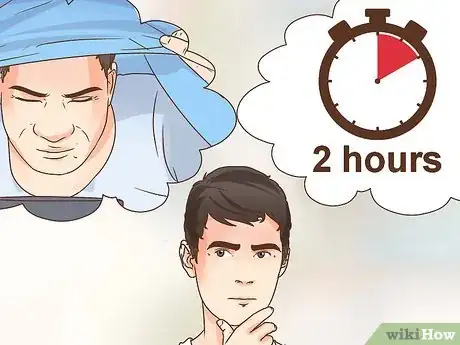
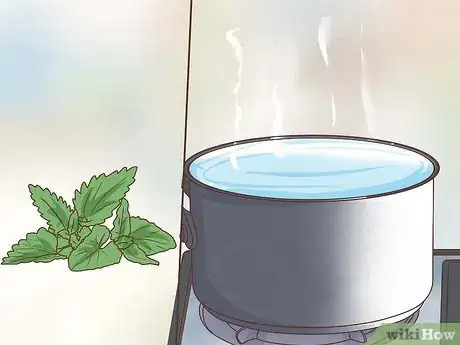
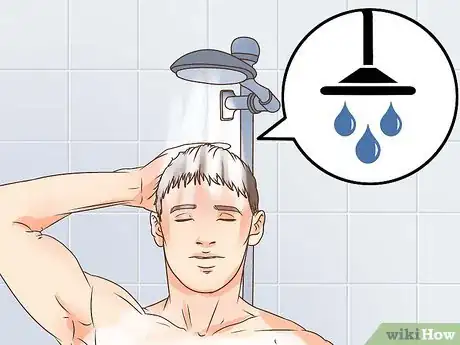
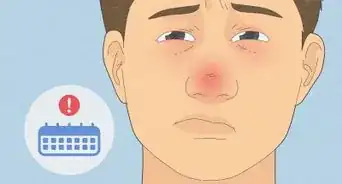

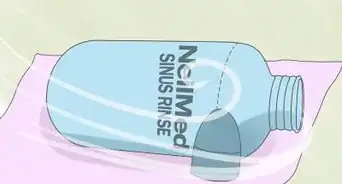
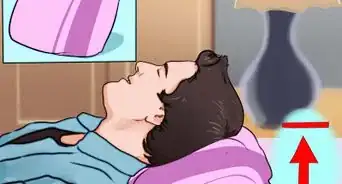
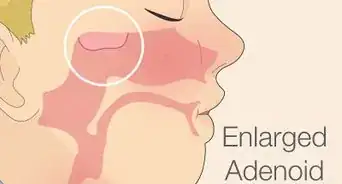
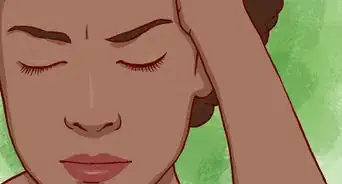



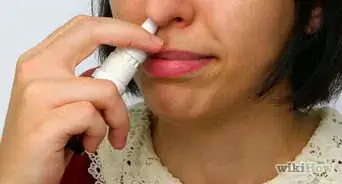












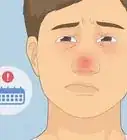


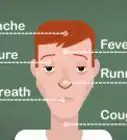



































Medical Disclaimer
The content of this article is not intended to be a substitute for professional medical advice, examination, diagnosis, or treatment. You should always contact your doctor or other qualified healthcare professional before starting, changing, or stopping any kind of health treatment.
Read More...